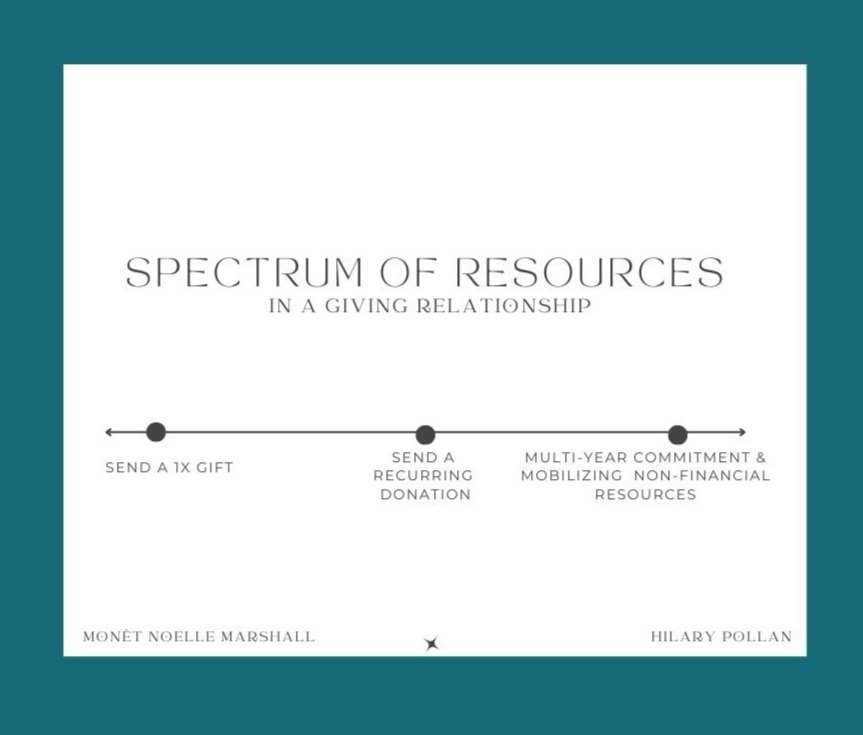As we shared in Part 1, well-stewarded giving relationships are possible! They require asking questions that allow both the Cultural Organizer and Donor to honestly name their needs and capacity from this relationship. Specifically, we encourage folks to explore the Spectrums of Resources and Relationships to define the depth and dynamics of the relationship.
Let’s explore the Spectrum of Resources and the questions Cultural Organizers and Donors may want to ask themselves and each other!
Spectrum of Resources
Resources, including money, is really where the rubber meets the road in a giving relationship. It’s the core impetus for the relationship between the Cultural Organizer and Donor, and YES it can be a foundation for constructive, two-way conversation filled with possibilities.
How much money will you ask for/give?
Most people start the money conversation in a giving relationship by thinking about the dollar amount. For us, the amount is less important because it will depend on the donor’s specific money context. Donors have a large range of access to wealth, and when and how they’re able to give depends on multiple factors (i.e. other giving commitments, access to cash and liquid assets, life and family responsibilities, etc). With that said, however, our basic rule of thumb is that folks with access to wealth should always commit to give as much as they can or a truly meaningful amount. And we encourage the cultural organizer to ask for the full amount they need. We believe that this emboldens the cultural organizer to speak clearly about their needs and educates the donor on the true cost of the work.
How will the money be moved?
What is often more important to the giving relationship than how much money, is defining how the money is moved. This spectrum extends from a one-time gift to recurring gifts on different scales (monthly, quarterly, annually) to a multi-year commitment.
How will this resource ‘ask’ evolve and/or change over time?
The amounts and how the money is moved are allowed to evolve over time. Cultural Organizers and Donors have permission to ask for the amount or frequency to increase or decrease. These requests to increase or decrease are best received when they are done transparently and with ample time to respond.
What other resources can be shared in the giving relationship?
Money is just one resource that can be mobilized in a giving relationship. When thinking about how much to ask for or give, consider what resources beyond money could be useful, such as making new connections with other donors or opportunities, access to space, taking a risk on behalf of the Cultural Organizer, and re-distributing some other form of power.
Money in Practice: A Cultural Organizer’s Perspective
Like many cultural organizers, some of my first donors were my friends. One set of friends in particular both supported my work with their financial resources and by connecting me with people in their network. These were connections I would not have had on my own and it increased the financial resources by 200%. It also reminded me of the power of asking for relational support as well as financial resources.
Photo by Derrick Beasley
This is the second in a 3-part series on stewarding a giving relationship between donors and cultural organizers. This blog series is co-created by myself and the excellent donor organizer, Hilary Pollan. This series comes ahead of An Exploration of Southern Cultural Organizing on April 16. During this participatory event we will expand our collective understanding of cultural organizing through conversation with Triangle NC-based artists and cultural organizers Derrick Beasley, Mike Williams, and Omisade Burney-Scott. There will be opportunities to connect and engage with other donors, funders, and cultural organizers, and explore how to engage in a giving relationship to support this transformational work.

